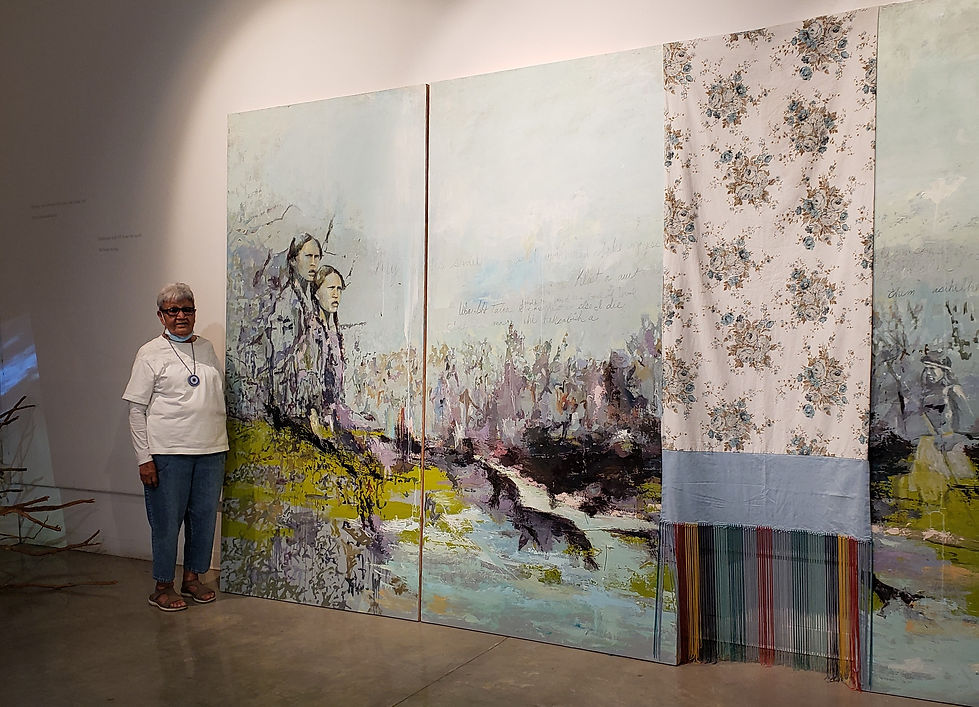WINYAN OMNICHA
THE GATHERING OF THE WOMEN
Winyan Omnicha, the Gathering of the Women
Oil, inks, and pastel on wood panels, Fabric, fringe, tree roots, video
8’ x 15’






Winyan Omnicha, the Gathering of the Women
(Oil, inks, and pastel on wood panels, Fabric, fringe and glass beads 8’ x 15’)
Winyan Omnicha, The Gathering of the Women is a painting is about the gathering of Native Women. In this painting, I wish to talk about the tribal act of healing and covering that was taught to me by my Lakota elders Winyan Ishnala, “Lone Woman," Corky Mills and Winyan Hunska, “Tall Woman," Millie Vela. Growing up, the women would gather. If someone were sick or needed help it was the woman provided the care for them. New mothers were guided and cared for. Projects like sewing quilts and shawls was communal. There was no one in charge it was simply a beautiful way to provide comfort. In this painting on three wood panels are Native women that represent all women gathered for covering and protection. They are all of the women erased and forgotten. They are the Native women who have disappeared at twice the per capita rate of white women. They are our little bundle carriers full of hopes and dreams. They are old women still full of dreams, grandmother who stand in the gaps for their families. My grandmother is here, over there is my mother, my sister, my friend. We are all here intermixed in pigments and paint. We all are here in this painting. I wish to call out of the need to the need to gather our women and children together.
There is a Ceremonial Shawl that hangs between the gaps of these paintings. It symbolizes a covering, a protection, a healing. The shawl was sewn by Winyan Ishnala, “Lone Woman," Corky Mills from the Cheyenne River Eagle Butte Agency, South Dakota and Winyan Hunska, “Tall Woman," Millie Vela descendants of Chiefs White Horse, White Swan, War Eagle and John Grass from the Cheyenne River Eagle Butte Agency South Dakota. Corky explained,
“As a woman you cannot enter a ceremony without a Shawl. To go into the Powwow you have to have a shawl. It is a protection, a covering against the cold. It is meant to be worn around your shoulders. Our people believed that you shouldn’t be out at night. If anyone were to reach out to us at night we knew immediately to pray. The person who made the shawls either painted or sewed designs on their shawl. The fringes that hang down to the ankles were used to chase the mosquitos away.”

Standing in the Gap of the Here and In Between is filmed mainly from the location that I have shared. As I walk along the edges of the waterway, stepping through the grass and dirt, it seems as if the clouds are in my reach. In this work, placed in before the video is the bottom half of a severed tree trunk and roots. This tree could no longer thrive as it should, its roots had become warped and twisted, because they could not grow freely under the soil. Beneath its tree roots was a cement-like layer of ancient hard-pan soil. The roots became blocked and entangled from the hardened earth layer, it caused the roots to spread out flattened and deformed. The farmer who owned the orchard where I found this tree explained that once the piles of dead trees are removed and burned they will use an equipment that will break the cement like surface layered soil. A new species of citrus will be planted here, that will grow freely once the ground is broken. This work plays as a challenge of colonialist ideologies. It is a metaphor of an unhealthy culture, entrapped in its warped, and twisted roots, its development disrupted by the hard-pan soil of a hidden history of violence, greed, and sorrow. Sometimes, as the wise farmer told me, the orchard must be removed, and all its trees and roots ripped out. Only then can the soil be broken.